
APPROACHING PLANET 3
Cultural Infusion Founder and CEO Peter Mousaferiadis presented a version of this paper to the 2022 International Mining and Resources Conference (IMARC) in Sydney, November 2022
Approaching Planet 3, approaching planet from the sun.
Wow!
I am in awe of its beauty. It looks so serene.
I have yet to see anything like it in the Milky Way let alone the entire Universe.
How about if I land and ask all its human inhabitants what they think?
Is this blue planet peaceful? Are they taking care of it?
Are they getting on with each other?
Human Earthlings can be defined by two major words commencing with the letter C.
Conflict and Culture.
Culture is overarching and underpinning. Every society has a culture. A way of thinking. A way of behaving. Social norms. All these guide society.
If you want social change you need to change culture; in other words, social change is embedded in cultural change.
Hold that thought. Let it resonate.

According to UNESCO, 75% of all conflict we have in the world has a cultural dimension and 89% of all current armed conflicts are occurring in countries with low intercultural dialogue, which strongly implies that peace can be mediated through intercultural understanding. More than 1.65 billion people may have been killed in such avoidable conflicts throughout history.

According to the Global Peace Index, established by Australian philanthropist Stephen Killelea, the cost of violent conflict in the world equates to almost 14% of the world’s GDP. In other words, the world is spending more than 10 trillion dollars a year dealing with conflict that has a cultural dimension. Conflict does not only mean war but is something we experience in our homes, communities and in our workplaces, often daily.
If culture-based conflict is so ubiquitous, why are we not putting culture at the heart of all education, development and progress?
The mining industry is valued at around 7% of the global GDP yet drives more than 45% of the global GDP through direct and indirect contribution.
According to the Smithsonian Institute director Richard Kurin, if you meld all the intangible aspects of culture to include sports, the arts, entertainment, media, cultural institutions and publications then the contribution of culture towards the GDP nearly equals that of the mining industry.
Our most underutilised resource is our collective cultural heritage, which is often referred to as cultural diversity.
The question is, why are we not drawing on this asset as a source of innovation, progress, sustainability, reducing poverty and social cohesion for everyone? The bionic eye, the numerical system and even the carbon-neutral desalination plants being built in Saudi Arabia today are due not to one single culture but to the convergence of many different disciplines coming together from across the globe to benefit all humanity.
Hence the slogan I coined, “Divided We Fall, United We Stand, Diversified We Grow”, for a United Nations (UN) campaign in 2013.
I believe the reason for the lack of attention to our collective cultural heritage is that it has been poorly defined, analytically neglected and lacks robust understanding. According to the UN there are 193 full member and 2 non-member states, about 60 dependent territories and some disputed territories.
However, within these geopolitical borders there exist more than:
- 11500 speech communities, variations and languages;
- 8500 distinct ethnic groups or cultures; and more than
- 8500 religions along with their branches and sub-branches.
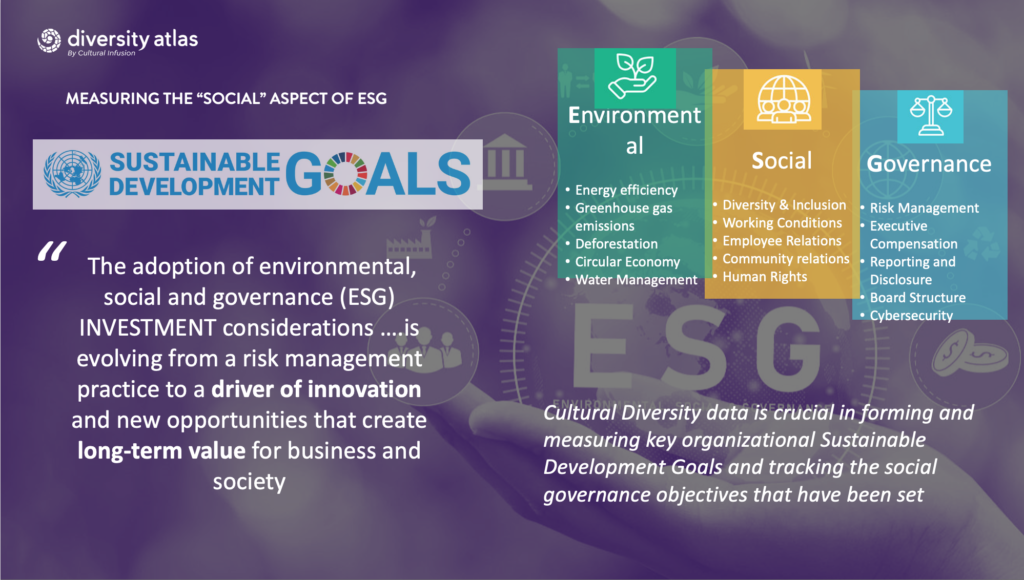
Today, no globally competing organisation can escape the ESGs.
ESG is an acronym for Environmental, Social and Governance and is a term used to measure the sustainability and ethical impact of a company.
Every investor, stakeholder, employee and even my children’s generation will look very closely at ESGs when making decisions about who to work for and who to invest with. School students today are being educated in Sustainable Development to prepare them to become global and responsible citizens.
But how do organisations measure how they are performing against these ESGs? First, we need to recognise that ESGs tie into Sustainable Development Goals (SDGs), which are linked, interdependent and accessible when we understand the diversity of our workforce.
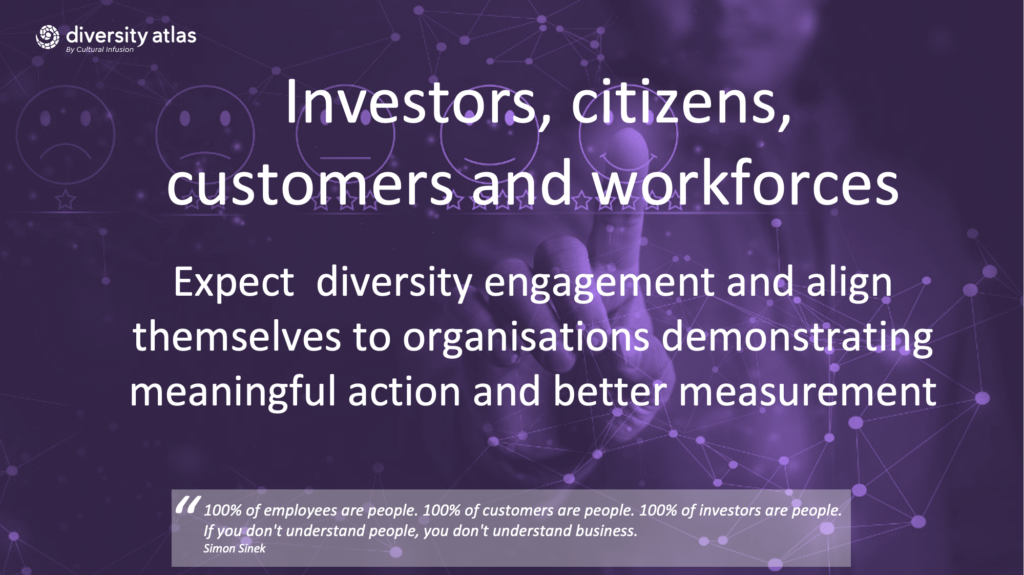
But do we understand our workforces?
The reality is that collectively we spend more than 200 billion dollars a year on marketing technologies in efforts to understand our customers. We now know our customers better than they know themselves. We even know what customers are going to buy before they do. Just ask Amazon and Google.
But do we know ourselves?
This was the question in 2015 my cultural enterprise wanted to answer.
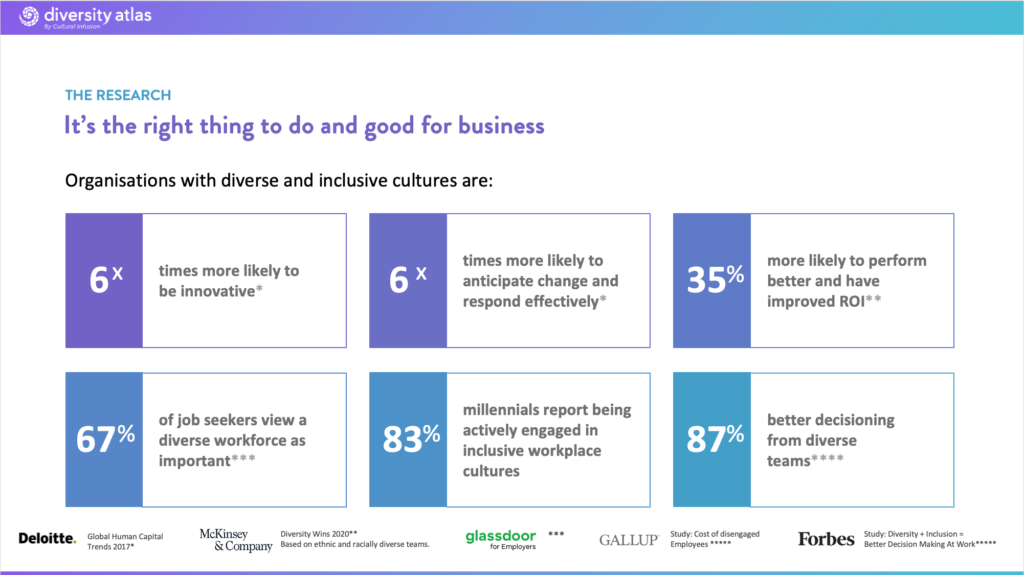
In May this year, I was invited to Washington DC to receive the Silver Medal for the Global Peace and Interfaith Award, a joint initiative of the United Nations Global Compact and the Religious Freedom Business Foundation. In the conference preceding the Award Ceremony, participants from multinational tech companies were expressing wonder that with all the computing power we have in the world we are yet to create disruption around societal challenges.
To put this into some context: since the 1989 advent of Tim Burners-Lee’s World Wide Web (WWW) the world has become super diverse and time and space have compressed. You would think the WWW would have made us more cohesive. What we instead experienced was massive economic globalisation without globalisation of values and ethics.
According to the Global Peace Index, peace has steadily declined since 2007 and according to the Gallup Institute other social indicators such as wellbeing and happiness have also sharply declined, even though the GDP per capita has increased in most countries.
Why?
Because we are now in closer proximity to each other than we’ve ever been but lack intercultural competency – in fact, we are living in a world where polarisation is amplified by social media.
Algorithms created by the largest tech companies assume that everyone is starting from the same place not only socially but culturally. This couldn’t be further from the truth. Intervention strategies that don’t take this into account are failing us. The ability to understand and relate to the other is paramount. I have been singing this song since first launching my enterprise. It was the driving impetus behind the 7+ years of RnD we invested into creating Diversity Atlas, a powerful software tool that ensures that every single person counts is not otherised and is included.
Think of those 11500 languages, 8500 religions and 8200 cultures that make up our collective culture, now intersect those dimensions of cultural diversity with gender identity, gender expression, biological sex, sexual orientation, job position type and level, age and a list of countless other diverse demographic dimensions and all of a sudden, every single person’s identity becomes as unique as a fingerprint. But because we anonymise the data, these ‘fingerprints’ remain private and unidentifiable.
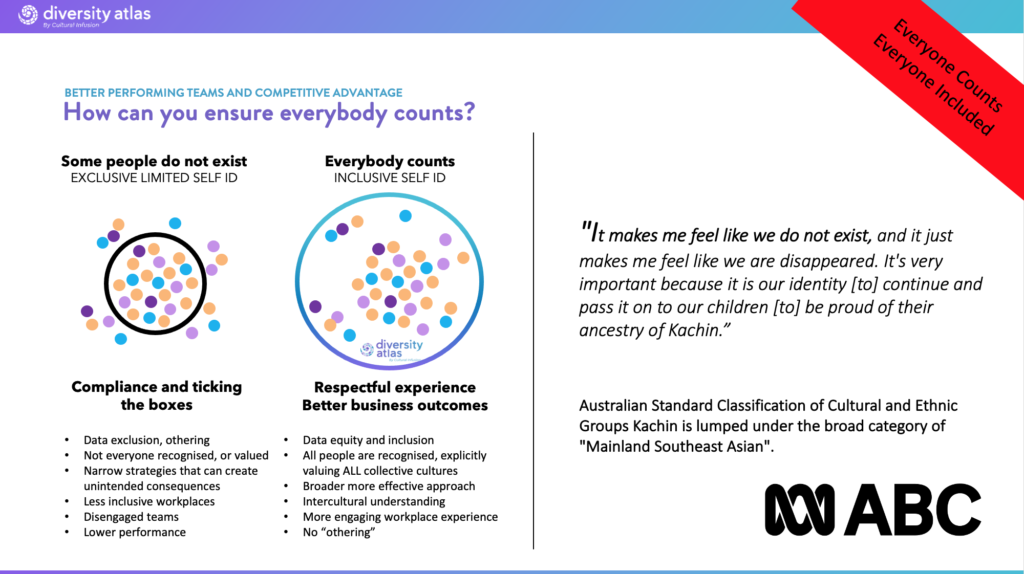
Diversity Atlas provides baseline data for organisations from which they can develop a range of targeted and nuanced strategies to make organisations inclusive, equitable and representative.
Through enormous computing power and the most comprehensive databases of humanity in the world, Diversity Atlas reveals statistical insights and endless possibilities.
It also allows organisations to track the progress of ESGs against the SDGs and present stakeholders with concrete information.
The concepts of representation and mutuality are also important. Mutuality describes the extent an organisation is reflective of the community it is delivering services or products to. All contemporary organisations need to be representative of the communities they are operating in if they are to avoid creating resentment, take advantage of the opportunity to build capacity in communities and achieve full potential and competitive business advantage.
There are countless examples of organisations failing to be representative and of the cost that comes with this.
We cannot underestimate the importance of embedding Diversity, Equity and Inclusion (DEI) into the DNA of an organisation.
This work is incremental, requires sophistication in data analytics and is forever changing. Why! Because culture is not static.
Diversity Atlas is appealing to companies as small as 80 all the way to the likes of Amazon with a global workforce of more than 1.6 million people. By improving their self-awareness these organisations are fostering greater intercultural understanding, alleviating conflict and aiming to bring out the best in their employees because they are empowered to apply long-term metrics and goals to their DEI initiatives and better relate to their environment.
Yes, what’s good for business will be good for everyone.
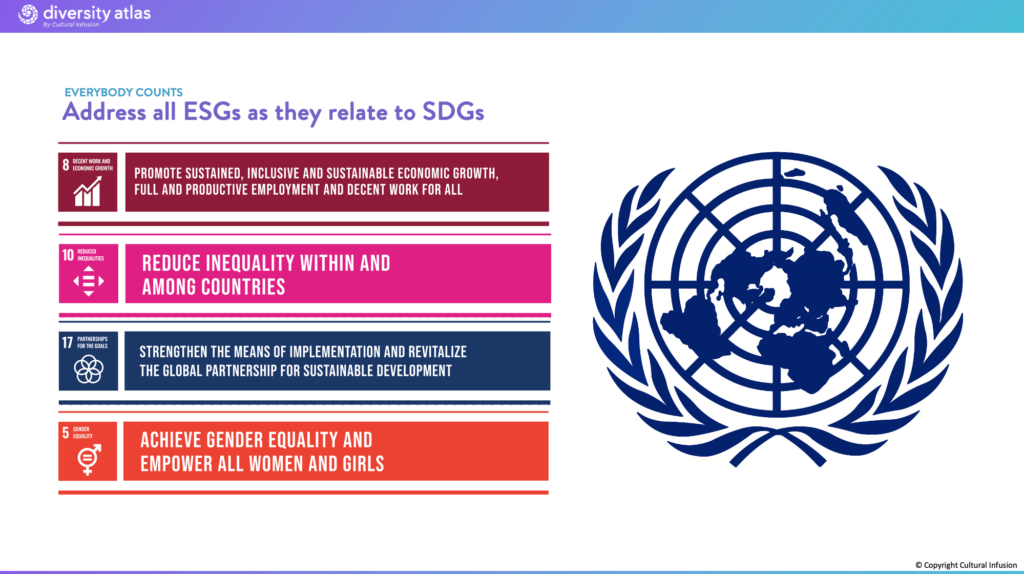
Diversity Atlas assists with addressing each of the ESGs as they relate to SDGS, including:
- SDG 8 – Decent work and economic growth
- SDG 10 – Reduced inequalities
- SDG 17 – Partnerships
- SDG 5 – Gender equality.
But more than this, our approach is an intersectional one. So, when we are looking at gender equality, we ensure that a multifactorial approach is taken so that there are not just more women but that women are represented throughout the organisation, including in leadership positions and, more importantly, they are representing the cultural diversity of the community they are operating in.
In Australia, until 2001 less than 0.1% of the staff employed in mining industries in Australia were Indigenous women when in some cases they made up more than 20% of the population in the locations of these companies. While there may be some cultural reasons behind this low rate, Indigenous disadvantage needs urgent addressing across the globe. Indigenous people make up about 6% of the global population and are stewards to about 20% of all land. They are often the first to be displaced by climate change. It’s estimated that by 2050 1.2 billion people will be displaced globally because of climate change. Learning to navigate our collective challenges with minimum conflict is good for business and good for humanity.

Earthlings, earthlings, consider what type of Earth you would like to leave behind for your children and their children’s children, and so on. And remember, you can’t manage the way forward if you can’t measure it.
Share this Post